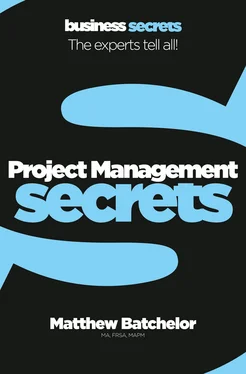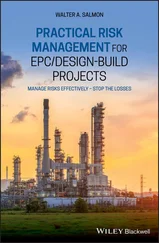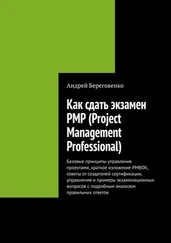Matthew Batchelor - Project Management
Здесь есть возможность читать онлайн «Matthew Batchelor - Project Management» — ознакомительный отрывок электронной книги совершенно бесплатно, а после прочтения отрывка купить полную версию. В некоторых случаях можно слушать аудио, скачать через торрент в формате fb2 и присутствует краткое содержание. Жанр: unrecognised, на английском языке. Описание произведения, (предисловие) а так же отзывы посетителей доступны на портале библиотеки ЛибКат.
- Название:Project Management
- Автор:
- Жанр:
- Год:неизвестен
- ISBN:нет данных
- Рейтинг книги:4 / 5. Голосов: 1
-
Избранное:Добавить в избранное
- Отзывы:
-
Ваша оценка:
- 80
- 1
- 2
- 3
- 4
- 5
Project Management: краткое содержание, описание и аннотация
Предлагаем к чтению аннотацию, описание, краткое содержание или предисловие (зависит от того, что написал сам автор книги «Project Management»). Если вы не нашли необходимую информацию о книге — напишите в комментариях, мы постараемся отыскать её.
Project Management — читать онлайн ознакомительный отрывок
Ниже представлен текст книги, разбитый по страницам. Система сохранения места последней прочитанной страницы, позволяет с удобством читать онлайн бесплатно книгу «Project Management», без необходимости каждый раз заново искать на чём Вы остановились. Поставьте закладку, и сможете в любой момент перейти на страницу, на которой закончили чтение.
Интервал:
Закладка:
Project Management
Secrets
The experts tell all!
Matthew Batchelor
Contents
Title Page Project Management Secrets The experts tell all!
Author’s Note Конец ознакомительного фрагмента. Текст предоставлен ООО «ЛитРес». Прочитайте эту книгу целиком, купив полную легальную версию на ЛитРес. Безопасно оплатить книгу можно банковской картой Visa, MasterCard, Maestro, со счета мобильного телефона, с платежного терминала, в салоне МТС или Связной, через PayPal, WebMoney, Яндекс.Деньги, QIWI Кошелек, бонусными картами или другим удобным Вам способом.
Good project management is vital to business success Good project management is vital to business success In today’s highly competitive business world, more and more organizations are moving to a project approach. Whether launching a new, multi-million-dollar product or planning an office move, project management will enable you to deliver high-quality results on time and within budget. Just as important, it provides a framework for continuous learning and improvement. In my own field of communications, I’ve spent over 20 years as a project manager, delivering projects as diverse as product launches and health conferences. I’ve observed a range of different project management approaches in action, and tried to adopt the best of them to improve the quality of the projects I manage. Successful project management is about good systems and good leadership, to be sure, but it’s also about exercising good judgement when required. This book will help you develop all three of these skills. It aims to impart what I believe are the 50 most important project management secrets I’ve learnt along the way. These secrets are divided into seven key chapters: Understand the role of projects. This section introduces you to the world of project management and helps you choose the right approach. Aspire to succeed. To start your project you need a clear ‘vision’ and the ability to convince people to support your project. Plan for success. Learn how to use Gantt charts, network diagrams and other essential tools for the project manager. Manage your money. This section tells you how to build a project budget, manage risks and allocate contingency (extra); it will also help you identify the key areas to focus on to keep costs under control. Lead and inspire your team. How to recruit, manage and fire up your project team. Turn your plan into reality. Introduces some of the most common project management software, shows how to monitor progress accurately, and how to diagnose and solve problems. Maximize project learning. Shows you how to close a project properly and conduct an effective evaluation. Whether you are an experienced project manager or novice, if you follow these simple rules, you will be more confident in your ability to lead projects succesfully. This book will not only teach you how to act like a project manager but also enable you to think like one!
Understand the role of projects Understand the role of projects This chapter aims to give you an understanding of the essential background to project management. It discusses the concept of the project life cycle, introduces the main stakeholders, and describes the role of the project manager. The most popular approaches to managing projects are discussed, along with some of the most popular software tools.
1.1 Projects are not tasks 1.1 Projects are not tasks Before getting started, it’s worth understanding what a ‘project’ actually is. The UK Association of Project Management (APM) defines a project as ‘a unique, transient endeavour undertaken to achieve a desired outcome’. In other words, a project has a defined beginning, middle and end, and a stated purpose. Managing a project therefore differs from fulfilling a task, programme or professional work role. The following list helps to differentiate a project from other types of work. • A project has a specified outcome. Unlike a job or work role where you are likely to have aims that change over time, a project sets out to achieve a stated goal (or goals) within a certain timetable. • A project involves a number of different tasks. These tasks are generally defined as the smallest useful units of work. Related tasks are often combined into work packages or activities, which can be assigned to a single supplier or team. • Each task will ideally be carried out by someone with suitable skills. Project working therefore calls for a multidisciplinary approach. The more complex a project, the greater the degree to which people and tasks need to be carefully matched. one minute wonder Are you still confused about what a project is? Take a moment to consider this: despite their very different sizes, delivering the 2012 London Olympics and relocating your team to an office down the corridor are both projects. ‘Being a sales rep’ is not a project because it is an ongoing work role. On the other hand, a plan ‘to deliver a 20 per cent increase in sales leads through the installation of a new marketing database’ is likely to fulfil the critera for a project. • A project is self-contained. It has its own aims, timetable and resources. That’s not to say that projects should be sealed off from the rest of the business – they can and should utilize skills and resources possessed by the wider organization, and the lessons learned should be exported to other colleagues and teams, and used on future projects. Though they are capable of standing alone, projects may be linked to a wider programme of work, or be part of a portfolio of similar projects. Adopting a project approach can yield significant benefits by defining clear outcomes against which to measure the input of resources and the quality of the project team and leadership. A project’s resources can be human, or financial or physical – equipment and so on.
1.2 Understand project constraints 1.2 Understand project constraints Planning your project will involve making a series of assumptions and a consideration of the constraints facing your project. Understanding these factors will help you plan a project that is of the right size and has appropriate objectives. The assumptions you might make about a project normally involve things such as: • Scope (scale). How big is the project? Where does it fit into what your organization is doing? Roughly how much money is likely to be available? • People. Who can I get to help deliver this project? • Physical resources. What equipment and meeting space, for example, will be available? None of this information has to be 100 per cent (or even 90 per cent) accurate at the outset. Nevertheless, understanding the assumptions around a project is an important first step – even if at this stage there are more questions than answers! A useful way of looking at the constraints faced by projects is known as the ‘project triangle’. This model describes three main things to consider for any project: • Time. How much of it do you have to complete your project? • Cost. What is the available budget? • Quality (or specification). Are you aiming to deliver something fairly basic, or more of a ‘Rolls Royce’ model? With any project you will face a series of decisions about whereabouts in the triangle you position your project. For example, let’s say you are asked to complete an office move for your company. If you are asked to complete the move over a weekend at short notice, and given only a limited budget, you are unlikely to be able to deliver the best results. So the costs and time used will be low, but so will the quality. If you are given more time, the results will be better; if you have more time and a bigger budget, they will be better still. Another dimension often added to this diagram is people. For any given amount of time and money, the greater the skill and motivation of the people involved, the better the results will be. Looked at this way, the triangle becomes a pyramid, with the project manager leading his or her team upward to achieve the best possible results within a given schedule and budget.
Интервал:
Закладка:
Похожие книги на «Project Management»
Представляем Вашему вниманию похожие книги на «Project Management» списком для выбора. Мы отобрали схожую по названию и смыслу литературу в надежде предоставить читателям больше вариантов отыскать новые, интересные, ещё непрочитанные произведения.
Обсуждение, отзывы о книге «Project Management» и просто собственные мнения читателей. Оставьте ваши комментарии, напишите, что Вы думаете о произведении, его смысле или главных героях. Укажите что конкретно понравилось, а что нет, и почему Вы так считаете.












